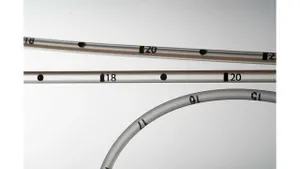The two steps every processor should take now to cut his energy bill? Chatting with The Rodon Group’s Lowell Allen
Reducing your company's overall operating costs by 12% is a dream for many plastics processors, but Lowell Allen, senior vice-president at The Rodon Group, and his tam have spent the past years making it their reality. He kindly joined us for a "chat" during the industry's first-ever Virtual Event, which we organized last Thursday, Sept, 8th under the title Continuous Improvement in Injection Molding.
September 9, 2011
Reducing your company's overall operating costs by 12% is a dream for many plastics processors, but Lowell Allen, senior vice-president at The Rodon Group, and his tam have spent the past years making it their reality. He kindly joined us for a "chat" during the industry's first-ever Virtual Event, which we organized last Thursday, Sept, 8th under the title Continuous Improvement in Injection Molding.
As Allen recalled, in order to identify where money can be saved in your molding operation (from an energy standpoint), one must first identify what processes are continuously running. "If you are a 24/7 molder, as we are, with 106 molding machines, it's best to prioritize each continuously running process. Of course, none of us have an unlimited budget, so it's important to investigate those areas that can be addressed that cost the least first, with the shortest payback time," he explained.
What runs continuously? At The Rodon Group, it is:
Molding machines
Cooling tower and pumps
Lighting
Air compressors
Granulators.
What energy-saving efforts has Rodon made?
According to Allen, his company the Nissei FNX Series of molding machines for their hybrid technology. "We have full-hydraulic machines as well as all-electrics. We like the accuracy and energy-efficiency of the all-electrics but found them lacking in a few areas, namely ejection advance force and nozzle-forward force. We like the full hydraulics for their robustness and durability. What we found and really like are the Nissei servo-driven hydraulic machines," he explained. These have the power of a full hydraulic with virtually the same energy efficiency of an all-electric, while using 40% less hydraulic oil than a full hydraulic, he added.
An attendee on the chat asked, "Which machine has a lower operating cost over a ten-year period (hybrid or all electric)? The reason we ask is because of ball screw wear and servo motor life. We are a closure molder." According to Allen,  his company has looked at that a lot and feels that over a 10-yr period the cost of replacement of ball screws on all-electrics outweighs the cost in the differential of electricity on a hybrid.
his company has looked at that a lot and feels that over a 10-yr period the cost of replacement of ball screws on all-electrics outweighs the cost in the differential of electricity on a hybrid.
A huge win for Rodon was its recent upgrade of its cooling towers to a maintenance-free fiberglass shell-cooling tower, which consumes almost 50% less energy and has 40% more cooling capacity. "We had 170-ton capacity steel-box cooling towers and the new ones are 240-ton capacity. This also means they cycle less often, and we have found they waste less water. We also were able to sell our old units to a scrap-metal recycler," he said.
New granulators help too
Allen added, "We are in the process of replacing our older, high-speed and noisy granulators with low-speed, low-energy, low-noise granulators. There is little or no dust created, and the decibel level in the plant has been greatly reduced. With the new equipment, workers are more comfortable, Rodon can more easily find those air leaks, and the new granulators are more efficient. According to Allen, "We have found that our low speed granulators consume only about 20-25% of the electricity of our higher speed granulators."
"Additionally, we have saved money and helped the environment by being a Certified Landfill-Free Facility. We do a lot of recycling and anything we can't recycle, we have hauled away by Sustainable Waste Solutions (SWS)," he explained.
"Our plant trash is then incinerated to create clean energy. SWS has a state-of-the-art facility that is live-monitored by the EPA and nothing except water vapor leaves the flue. They currently provide clean energy to about 32,000 households in our area," he said.
As he explained, Rodon currently is applying for additional state and federal subsidies with the assistance of its electric supplier, Pennsylvania Power and Light (PPL), based upon higher throughput (lbs of resin) per KWH used. It is a measurable accepted from our industry as a way of determining improved energy efficiency.
An attendee whose company sells energy-saving kit to injection molders, Robert Knaster of Plastic Metal USA Ltd., the distributor of Syncro Speed motor controls, added that in his experience the PPL programs pay $0.10/kWh saved on measurable projects.
Allen noted that even beyond the obvious benefit of reducing the company's own costs, there is significant good will for processors from customers if a processor can prove his energy-saving ways. "The major retailers are big drivers of going green and our push for sustainable efforts," he added.
Two things every processor should do?
Allen had two simple-but-proven suggestions all molders and plastics processors should consider to cut their energy bills. "The simplest thing all molders can do, and do quickly, is to upgrade plant-wide lighting. We had metal-halide lighting and converted to high-efficiency T-5 fluorescent lighting, with reflective hoods which provide better light. Each fixture has an occupancy sensor (motion detector), which allows the lights to 'blink off' when no one has been in the area for more than 10 minutes. They come on instantaneously when motion is detected."
He continued, "This is especially useful (and cost-effective) when we run a limited number of machines on weekends. Only the area we are running is lit. All other areas are dark, unless someone walks into that area. This has allowed us to save about $5000.00 per month on our energy bills, and the payback was about 16 months. We also noticed it to be cooler in the plant in the summer as the metal-halide lights generate heat up to 1875 degrees."
" Also, if you don't have variable speed air compressors (which we don't yet) the next best thing to do is FIX YOUR AIR LEAKS [Ed.: Allen's emphasis]. It's amazing how much air can be lost in a pressurized system through vacuum loaders, robots and leaking air hoses. It's equally amazing how much that costs to waste air...This can be determined through an air study (often performed by your air compressor supplier or maintenance company). We chase down our leaks on weekends (when it's quieter) or during our annual maintenance shutdown week."
Also, if you don't have variable speed air compressors (which we don't yet) the next best thing to do is FIX YOUR AIR LEAKS [Ed.: Allen's emphasis]. It's amazing how much air can be lost in a pressurized system through vacuum loaders, robots and leaking air hoses. It's equally amazing how much that costs to waste air...This can be determined through an air study (often performed by your air compressor supplier or maintenance company). We chase down our leaks on weekends (when it's quieter) or during our annual maintenance shutdown week."
We asked, "Do you track energy use for all of your equipment?" As Lowell Allen explained, "We attempt to but some equipment is more difficult to quantify such as air inefficiency - but we can tell you that there is a tremendous amount of savings that can occur and should be addressed by all manufacturers." Asked if Rodon brought in external auditors to monitor the equipment or for energy-saving advice, he responded with a resounding, "Absolutely! We rely on our individual equipment suppliers who all offer assistance in determining energy or air usage. Most are happy to provide a free audit, so why not?"
Knaster also added, "Some speed controls show on display screens the energy efficiency for every shot; that's as transparent as you can get" for energy use of a machine, to which Allen agreed.
Another participant asked about Roton's experience with ceramic heater bands, but Allen said the company has not used them; it does have insulated covers on each of its heater barrels.
Lowell Allen summarized, "The above steps have allowed us to save about $7000.00 per month on our energy bills, and the payback was about 24 months overall. We have saved money, while improving our efficiency (and bottom line) and helped the environment while doing so!" A final question from an attendee: "Lowell, what have you been able to achieve with respect to overall utility cost as a percentage of total plant burden?" "We have been able to reduce overall costs by about 12%," noted Allen.
Interested in learning more about the company? Visit its website for more information at www.rodongroup.com.
About the Author(s)
You May Also Like


